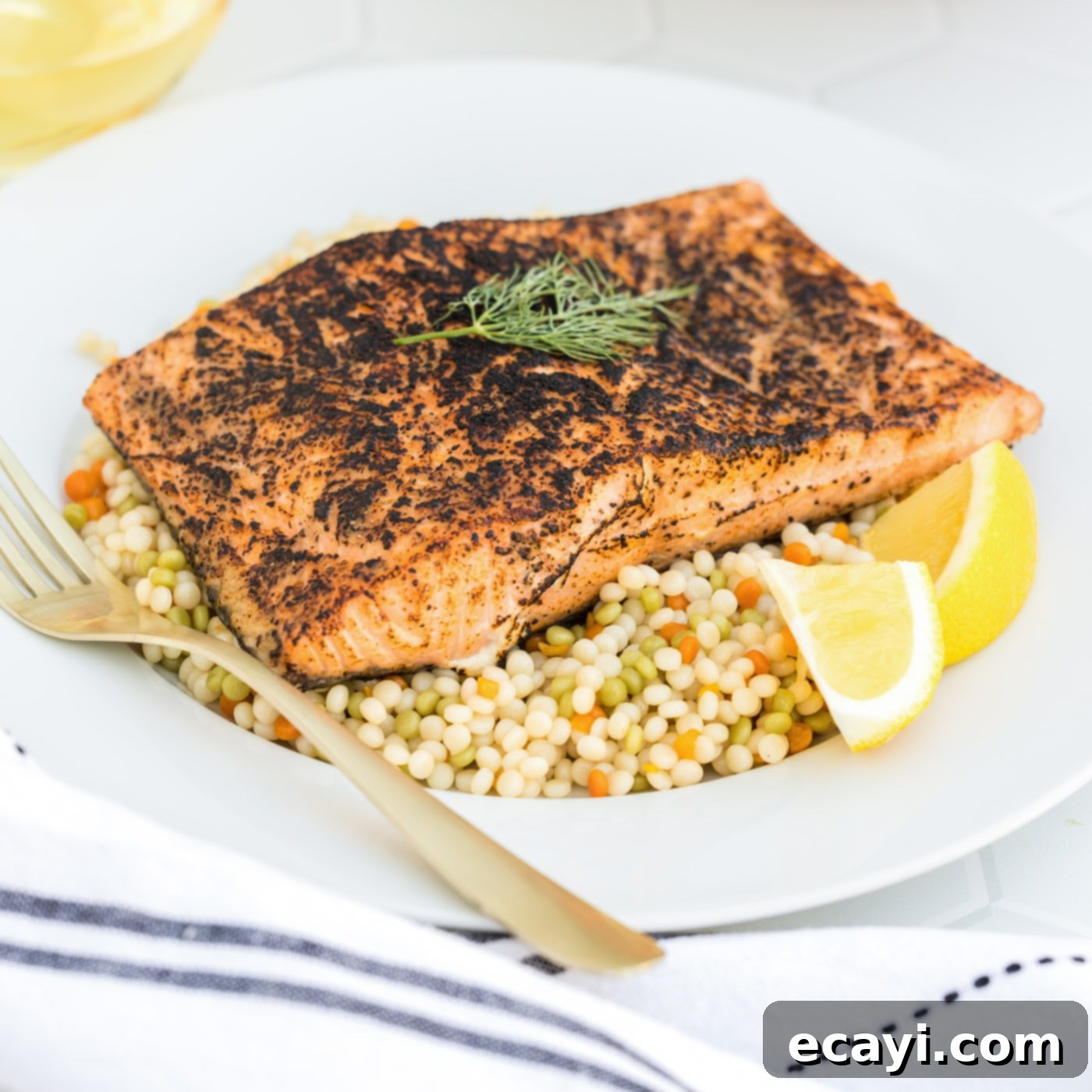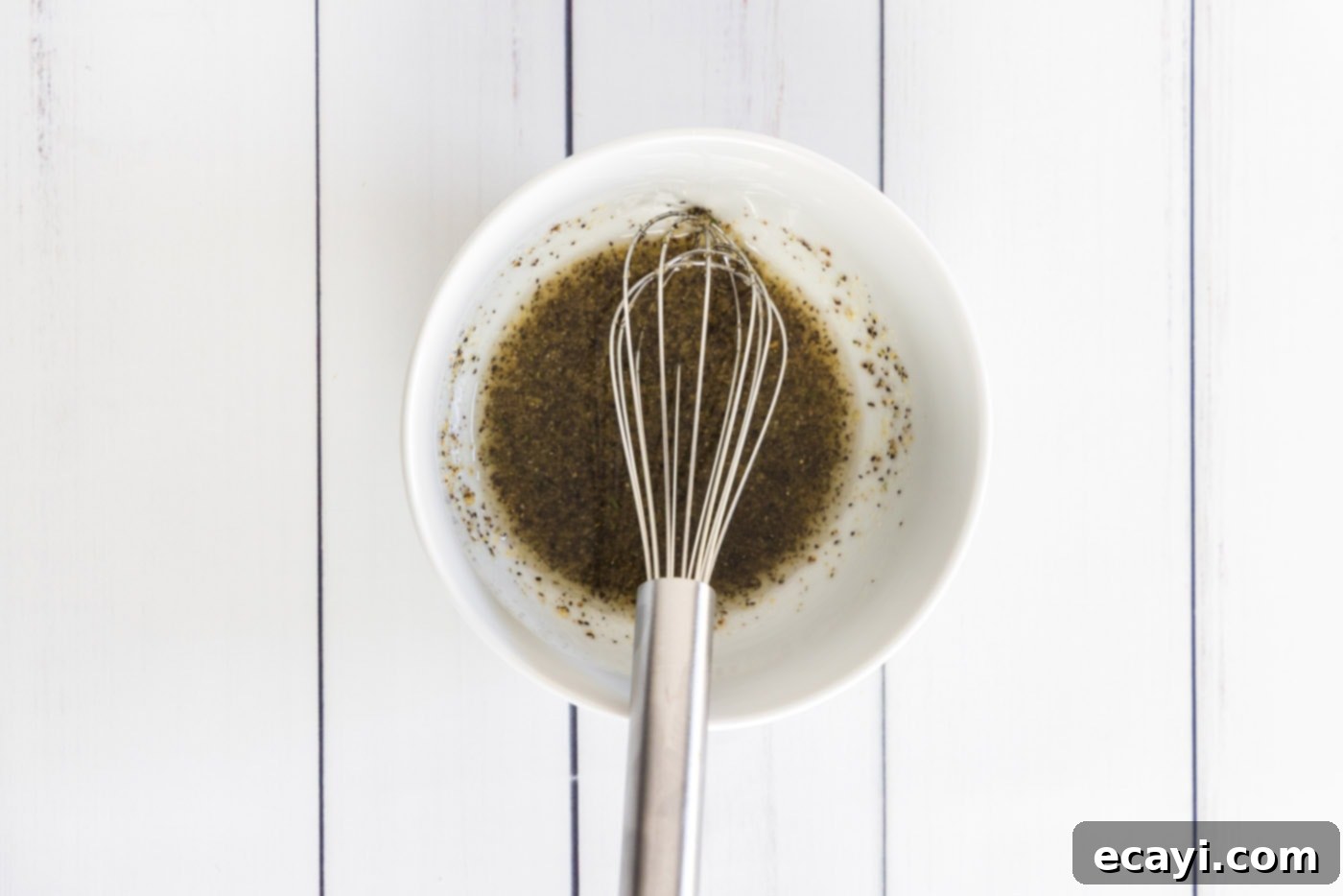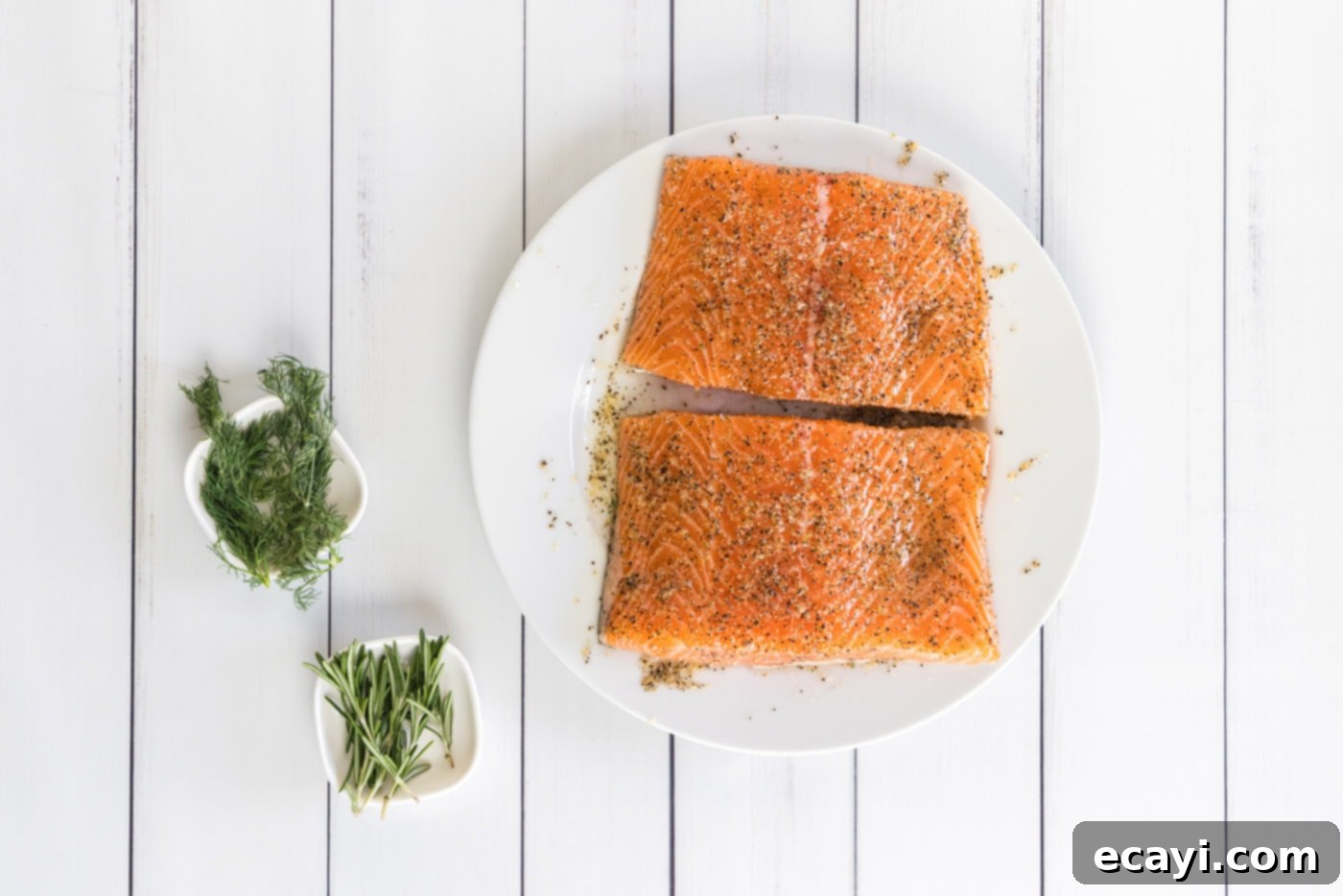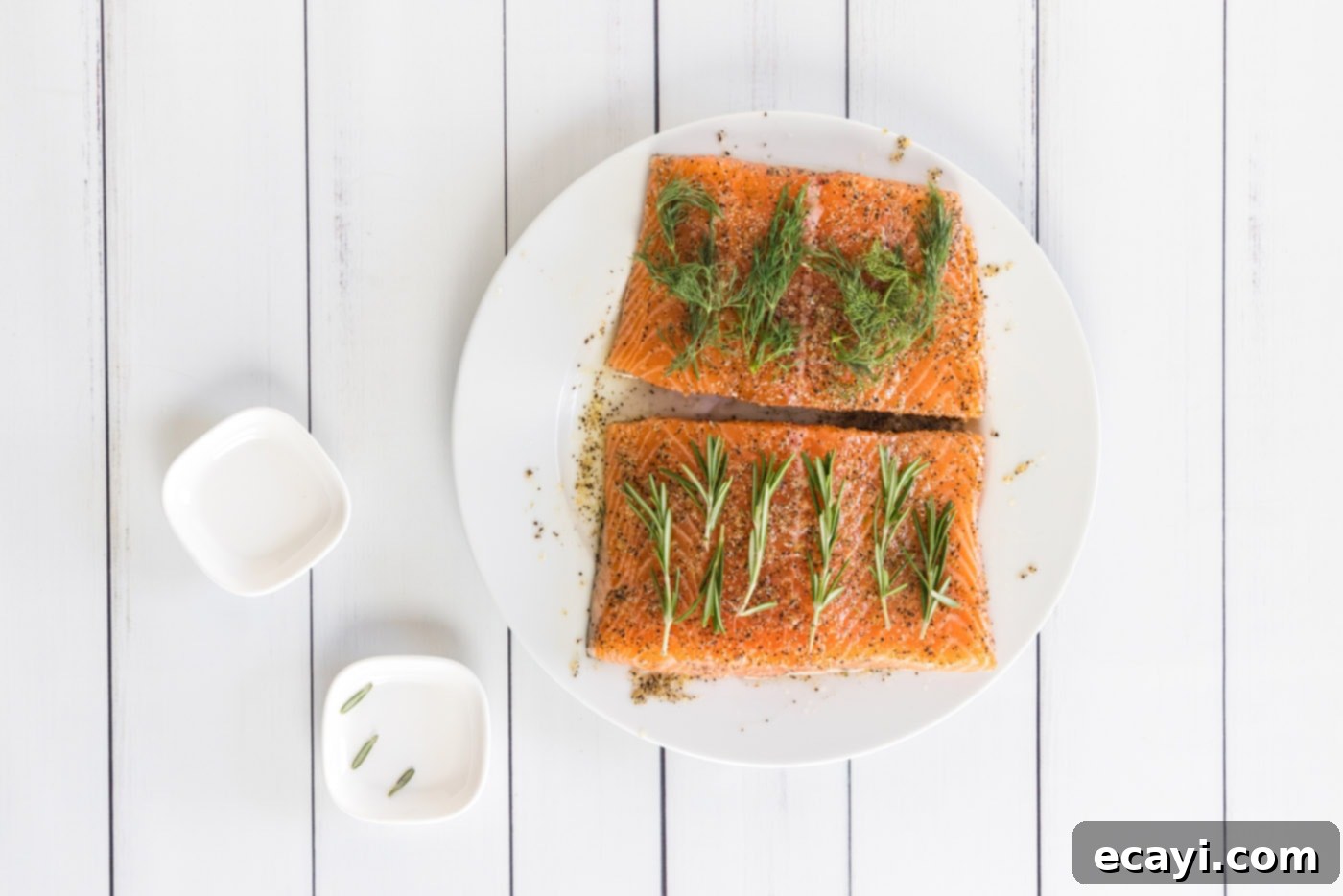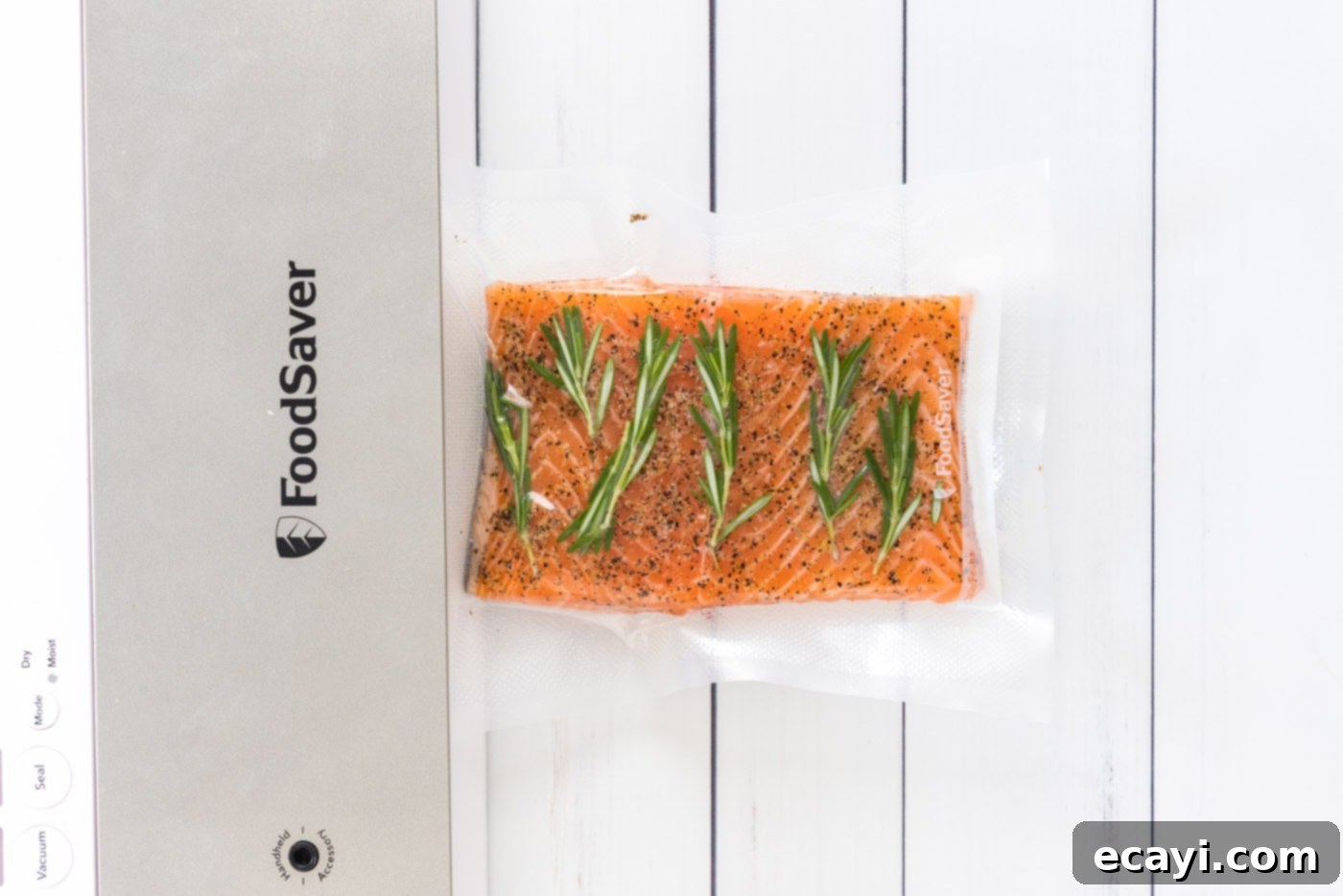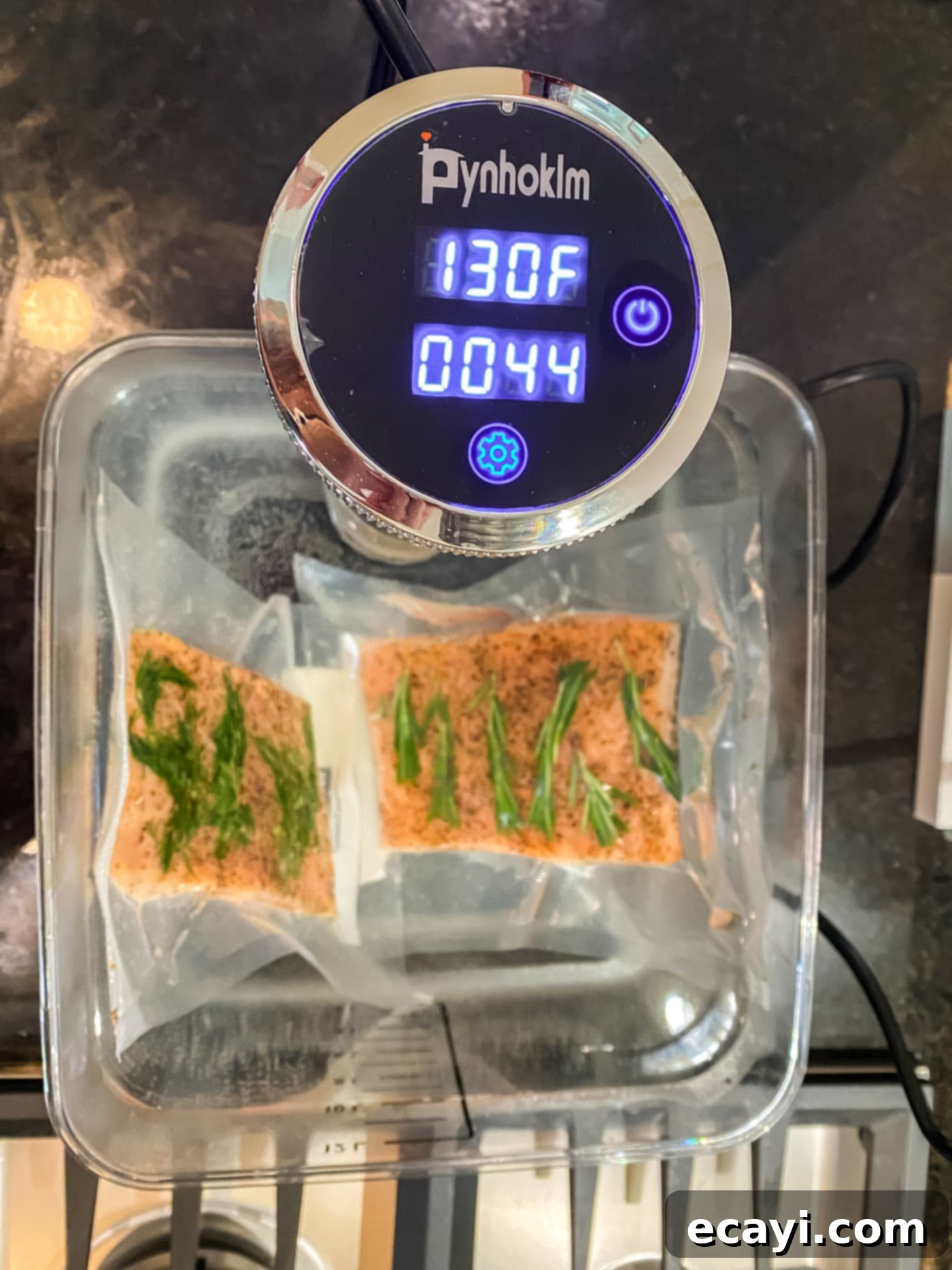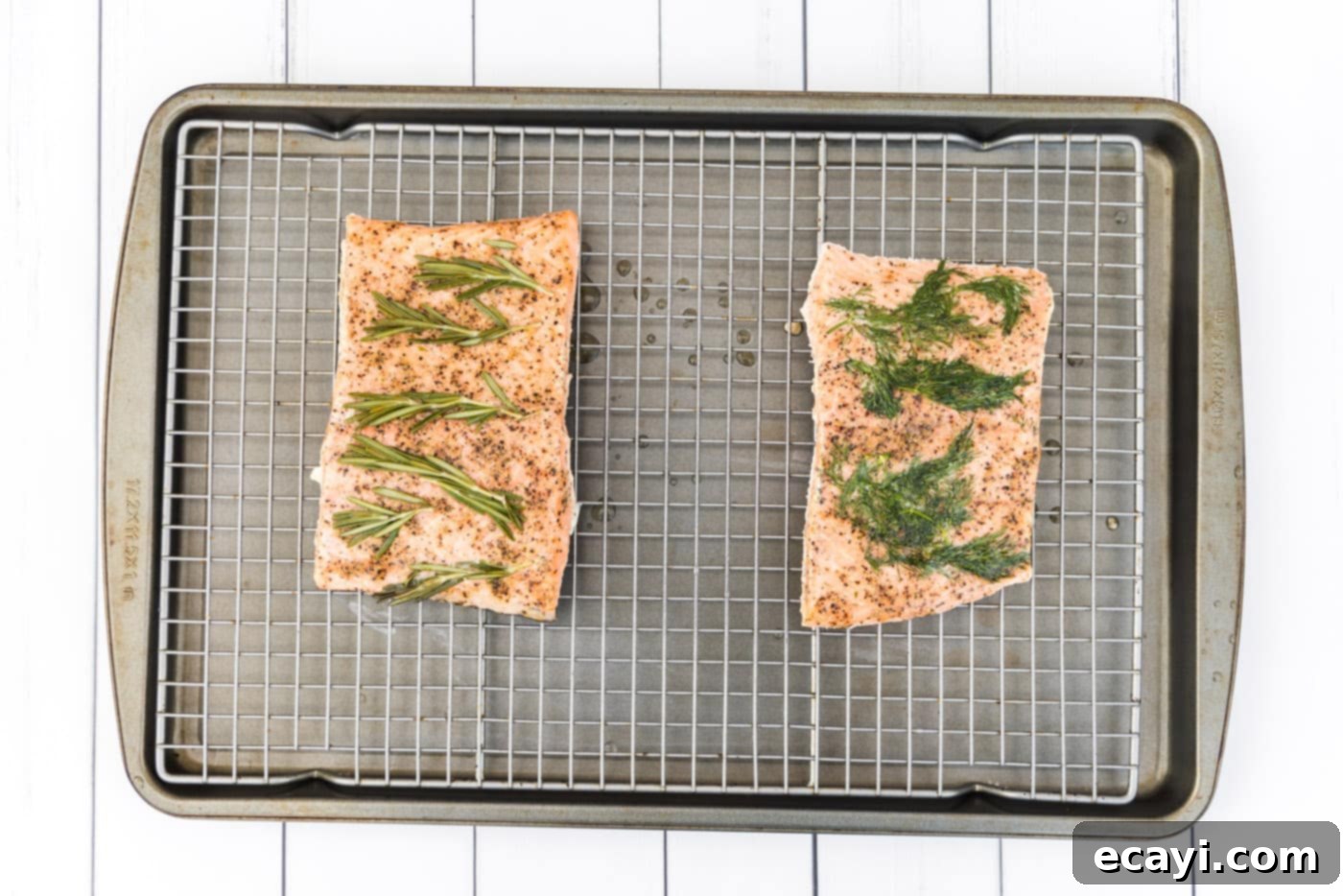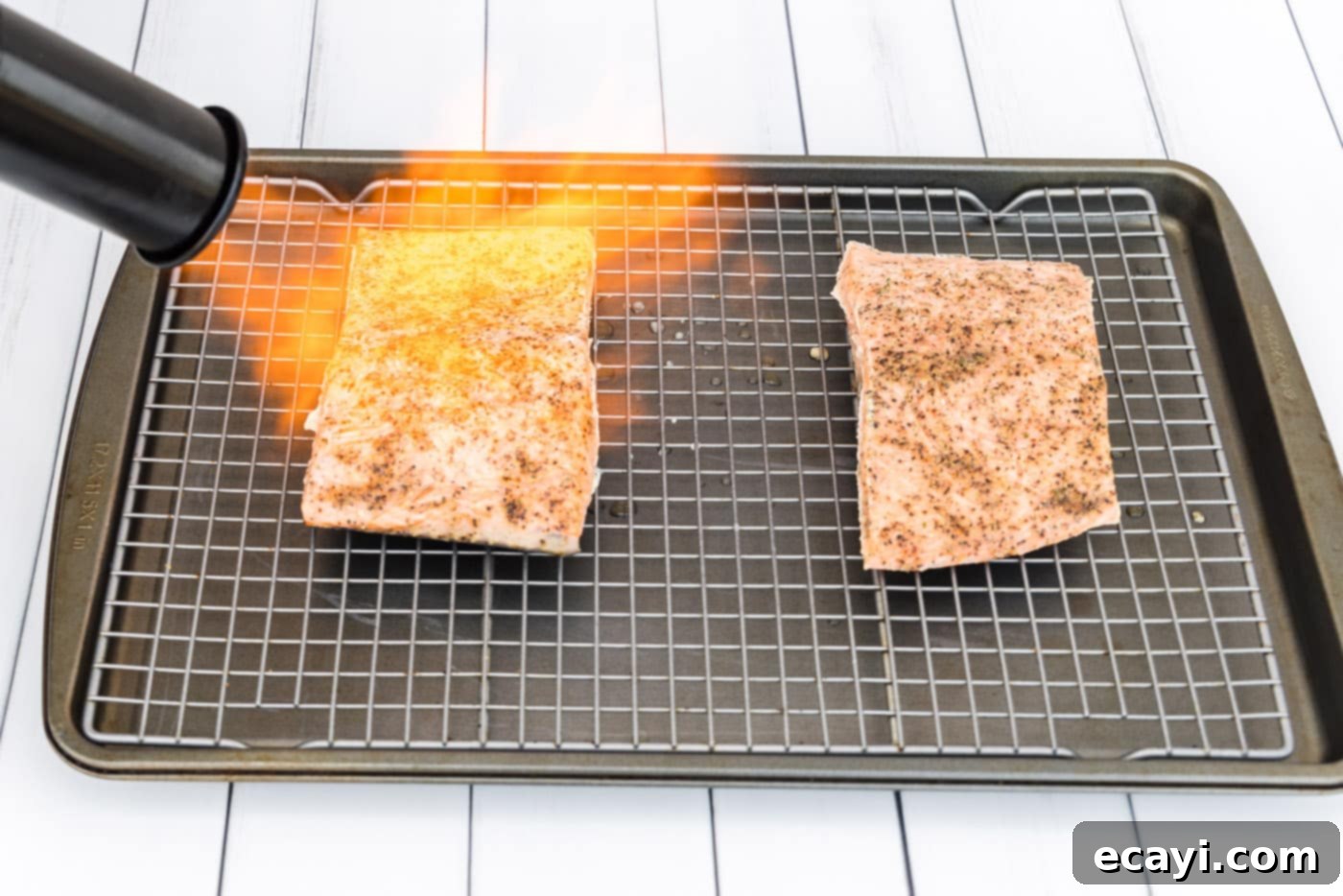Achieve Flawless Flakey Perfection: Your Ultimate Guide to Sous Vide Salmon
Prepare to discover the secret to consistently perfect salmon with the sous vide method! This hands-off technique delivers an unbelievably flakey, fall-apart tender salmon that’s moist, succulent, and bursting with flavor. The precision cooker takes all the guesswork out of cooking fish, guaranteeing ultra-moist fillets with minimal effort on your part. Say goodbye to dry, overcooked salmon and hello to culinary excellence.
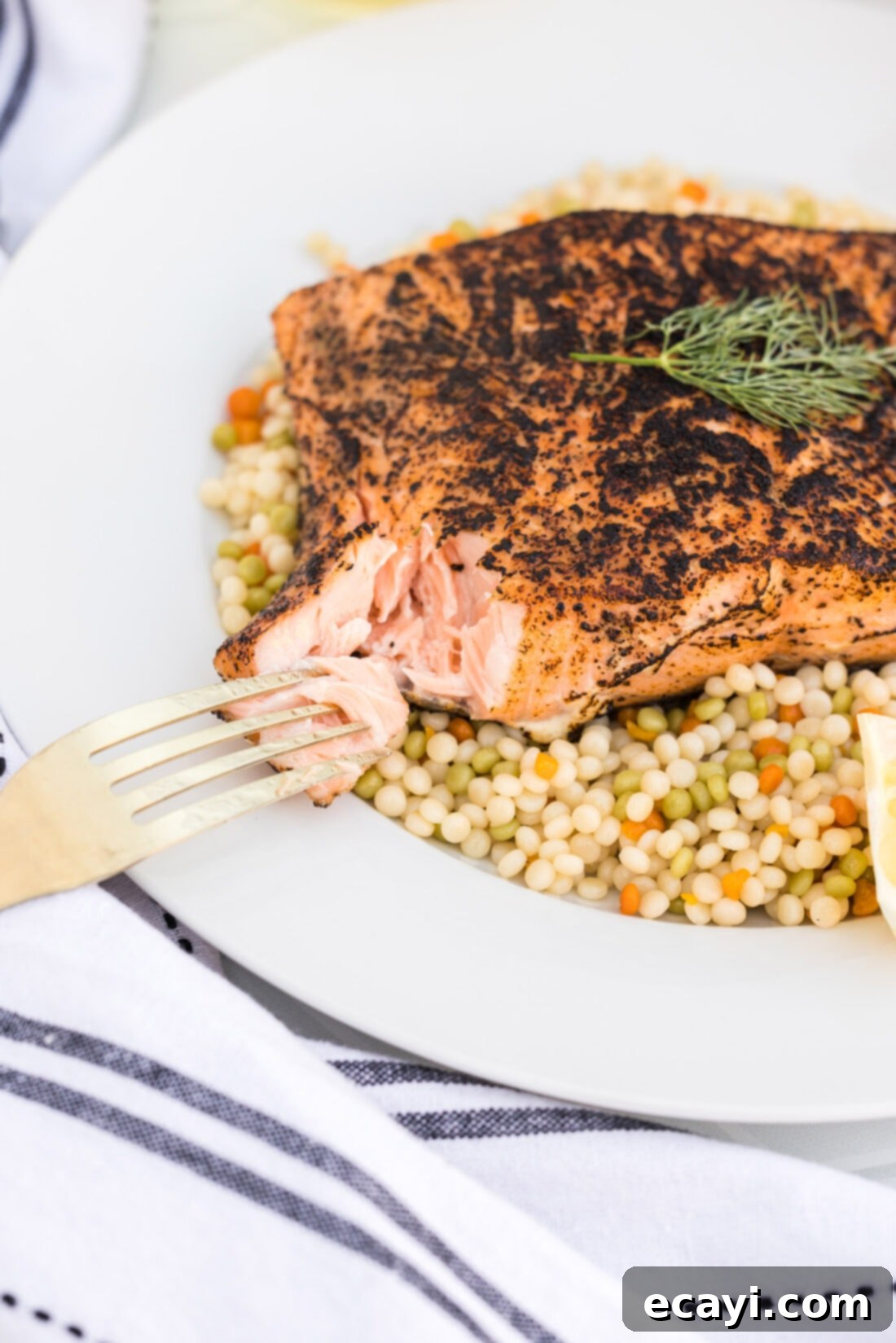
Why Sous Vide Salmon is a Game-Changer
Sous vide salmon stands out as a superior cooking method for several compelling reasons. It consistently produces the most delicate, juicy, and flakey salmon you’ll ever experience. While we appreciate the flavors of baked salmon and grilled salmon, those methods can be notoriously tricky when trying to pinpoint that perfect moment of doneness. Overcooking salmon by just a minute or two can result in a dry, lackluster fillet. With sous vide, the precision cooker completely eliminates this challenge, handling all the responsibility with unparalleled accuracy.
The magic lies in the precisely regulated water bath. By cooking salmon at a consistent, low temperature, the protein fibers cook evenly from edge to center, preventing any part of the fish from drying out. This meticulous temperature control ensures that your salmon reaches an ideal internal temperature without ever exceeding it, locking in all the natural moisture and delicate flavors. The result is a uniformly cooked fillet that is incredibly tender, moist, and practically melts in your mouth.
Once the salmon has reached its perfect internal temperature in the water bath, we apply a finishing sear. This is crucial for developing a beautiful, golden-brown crust and adding another layer of texture and flavor. A kitchen torch offers a quick and effective way to achieve this without significantly increasing the internal temperature of the fish. Alternatively, you can pan-sear the fillets, but it’s important to be incredibly swift and careful during this process. Since the salmon will already be perfectly cooked, extended time in a hot pan could lead to overcooking the outer layer, detracting from the delicate texture achieved through sous vide.
Beyond the flawless results, sous vide salmon is also remarkably hands-off. Once the salmon is seasoned and sealed in its bag, it simply cooks in the water bath while you focus on preparing side dishes or simply relaxing. This convenience makes it an ideal choice for busy weeknights or for entertaining guests when you want to impress without being chained to the stove.
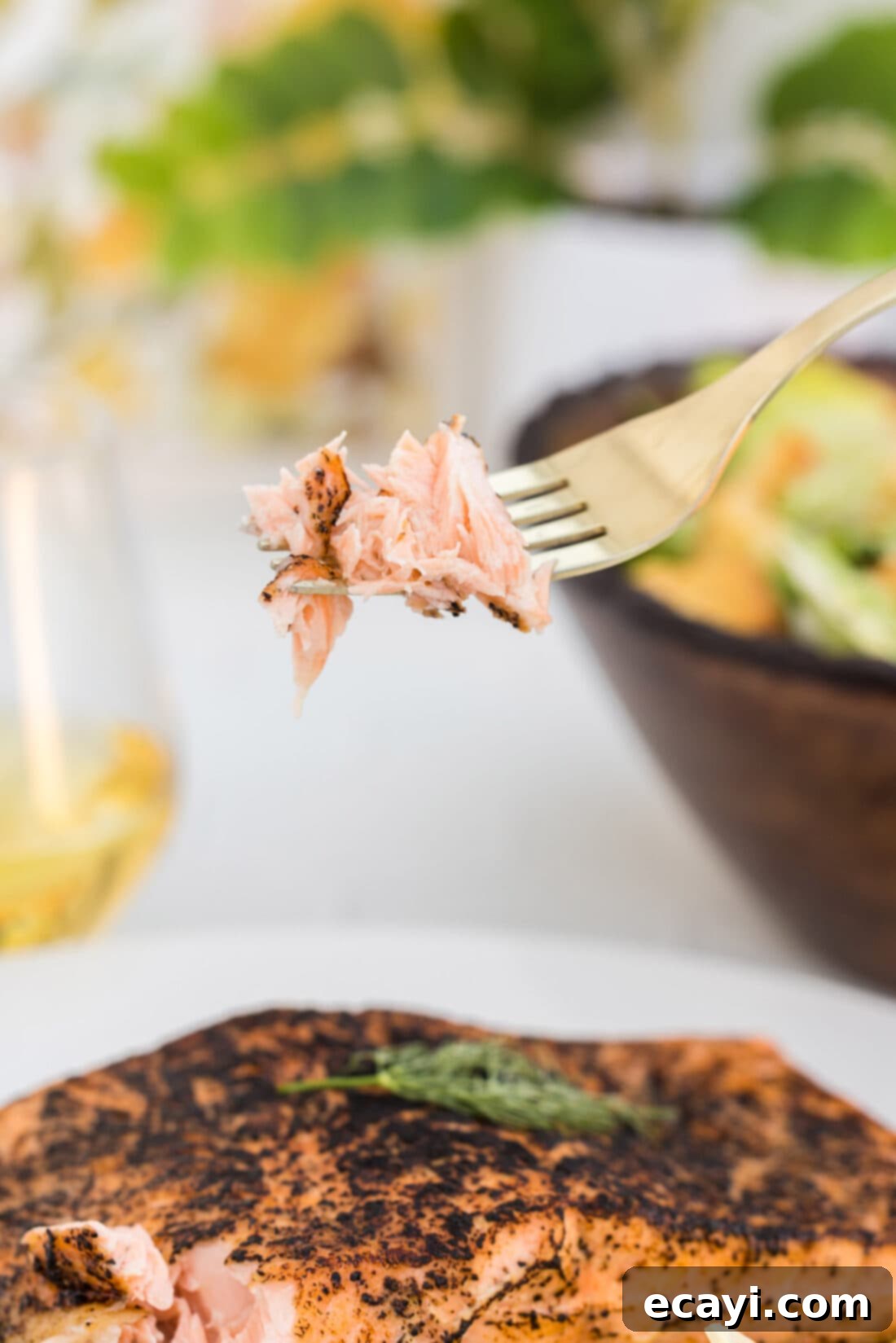
Essential Ingredients for Perfect Sous Vide Salmon
Crafting exquisite sous vide salmon requires only a few simple, high-quality ingredients. You’ll find all precise measurements, ingredients, and detailed instructions in the printable recipe card located at the end of this post.
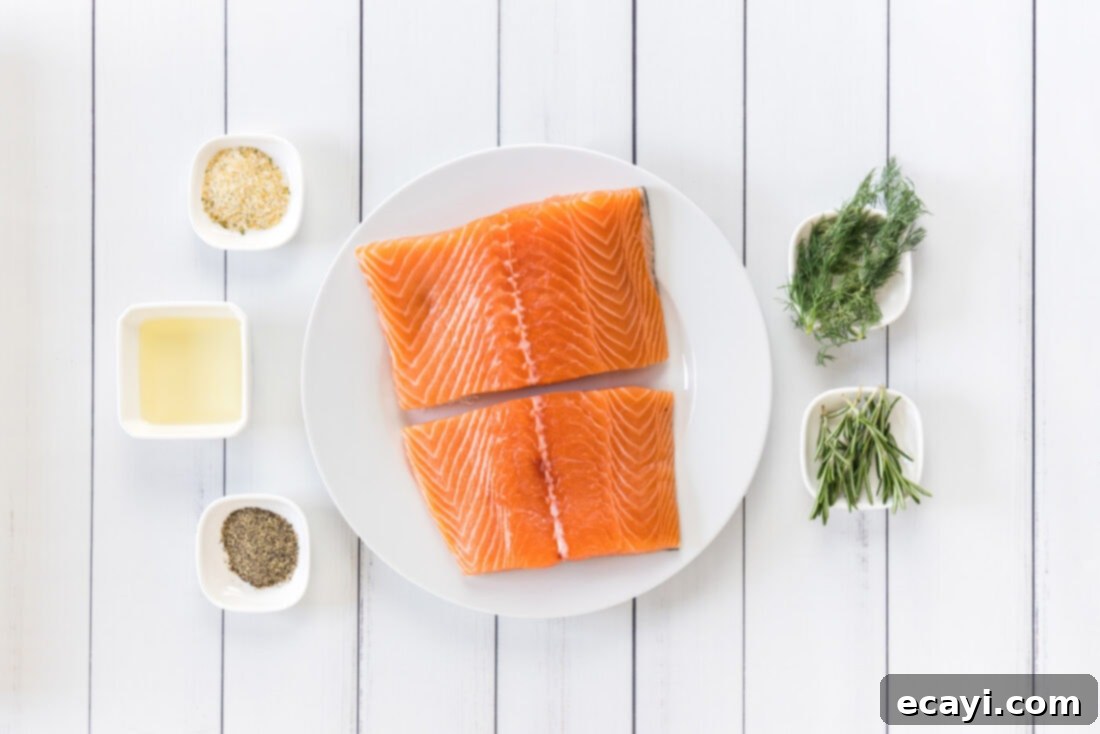
Ingredient Spotlight & Expert Tips
To ensure your sous vide salmon is nothing short of spectacular, paying attention to your ingredients is key:
SALMON – For the best results, always opt for fresh, high-quality salmon. We recommend using center-cut salmon fillets, ideally cut into two large, even pieces. Center-cut portions tend to be thicker and cook more uniformly, which is ideal for the sous vide method. You can choose between skin-on or skin-off; skin-on offers a crispier exterior if you plan to sear it well, while skin-off can be easier to handle for some. Atlantic, Sockeye, or Coho salmon are all excellent choices, each offering slightly different flavor profiles and fat content.
HERBS – Fresh herbs are invaluable for infusing tons of vibrant flavor into your salmon. While we’ve chosen the classic combination of fresh dill and rosemary for their aromatic qualities and complementary notes, feel free to experiment with your favorite aromatics. Thyme, tarragon, parsley, or even a bay leaf can provide wonderful depth. You could also add a slice of lemon or orange, or a few thin slices of ginger, into the bag for an extra layer of brightness. The sealed environment of the sous vide bag ensures that these flavors truly penetrate the fish.
OLIVE OIL, GARLIC SALT, & BLACK PEPPER – These pantry staples form the foundational seasoning for our salmon. Olive oil helps to distribute the flavors and contribute to moisture. Garlic salt provides a savory baseline with a hint of garlic, while freshly ground black pepper adds a touch of warmth and spice. Feel free to adjust the amounts to your taste, or consider adding other seasonings like onion powder, smoked paprika, or a pinch of red pepper flakes for a bit of heat.
Step-by-Step Guide: Crafting Your Perfect Sous Vide Salmon
These step-by-step photos and detailed instructions are designed to help you visualize each stage of making this incredibly delicious recipe. For a complete printable version, including all precise measurements and ingredient lists, simply jump to the recipe card at the bottom of this post.
- Begin by preparing your sous vide setup. Fill your sous vide water container with water to the recommended level (usually between the min and max fill lines). Securely position your sous vide immersion cooker into the container. Set the temperature on your sous vide cooker to 130°F (54.4°C) and allow it to preheat fully. This temperature is ideal for a medium-rare to medium salmon, offering a beautifully tender and moist texture.
- While your water bath is heating, prepare your seasoning mixture. In a small bowl, combine the olive oil, garlic salt, and black pepper. Whisk these ingredients together until they are well blended. This creates a flavorful oil rub that will adhere beautifully to your salmon and infuse it with taste during the sous vide process.

- With gloved hands, carefully coat both sides of each salmon fillet with the prepared oil mixture. Ensure that the seasoning is evenly distributed across the entire surface of the fish. This step is crucial for flavor development and helps to create a protective layer that keeps the salmon moist.

- Next, prepare your fresh herbs. Break the rosemary sprig into a few smaller, manageable pieces. Avoid chopping it too finely, as you’ll want to easily remove the herb pieces after the salmon has cooked. Gently place these herb pieces, along with any other fresh herbs like dill, on top of the seasoned salmon fillets. These aromatics will impart a wonderful fragrance and subtle flavor to the fish as it cooks.

- Carefully place each seasoned salmon fillet, along with its fresh herbs, into separate vacuum seal bags. It’s best to use one fillet per bag to ensure even cooking and easier handling. Once the salmon is inside, use your vacuum sealer to remove all the air and securely seal the bags shut. If you don’t have a vacuum sealer, you can use the water displacement method with a Ziploc bag: submerge the open bag with the salmon into the preheated water, allowing the water pressure to push out the air before sealing it just above the waterline.

- Once the water bath has reached 130°F (54.4°C), carefully place the vacuum-sealed salmon bags into the preheated water. Ensure the bags are fully submerged and that there’s enough space for water to circulate around them for even cooking. Sous vide the salmon for 45 minutes. This duration is generally perfect for achieving that signature delicate, flakey texture without any risk of overcooking.

- After 45 minutes, carefully remove the cooked salmon from the water bath. Open the vacuum seal bags and gently transfer the salmon fillets onto a wire rack. Discard the spent herbs from the bags. Pat the salmon dry with a paper towel; this step is critical for achieving a good sear in the next stage.

- For the final touch, use a kitchen torch to sear the outside of the cooked salmon. Move the torch quickly and evenly over the surface until a light, golden-brown crust forms. This adds a fantastic texture contrast and enhances the overall flavor without cooking the interior further. If you don’t have a kitchen torch, see our expert tips below for pan-searing alternatives.

Frequently Asked Questions & Expert Tips for Sous Vide Salmon
Absolutely! One of the fantastic advantages of sous vide cooking is its ability to handle frozen ingredients with ease. You can use frozen salmon following the same instructions outlined in the recipe. However, you will need to add an additional 25-30 minutes to the cooking time when starting from frozen, bringing the total sous vide time to about 70-75 minutes. When cooking from frozen, seasonings like garlic salt and pepper might not adhere as well, and you won’t need to apply olive oil before sealing. Nevertheless, you can still generously sprinkle salt and pepper over your frozen fillets before cooking, provided they were not purchased pre-vacuum-sealed with other marinades. If they are already sealed, simply proceed as is.
While a kitchen torch provides an excellent, quick, and even sear without overcooking the delicate interior, it’s not strictly necessary. Instead of a kitchen torch, you can simply sear the sous vide salmon in a hot skillet with a small amount of olive oil or butter. The key is to get your pan very hot before adding the fish, allowing you to sear it quickly for just 60-90 seconds per side, or until a beautiful golden crust forms. Since the fish is already perfectly cooked through, it’s crucial to minimize its time in the pan. If you take too long to sear it, the delicate fish could begin to flake apart or dry out. Cast iron or stainless steel pans work best for achieving a great sear. For an alternative finishing method, you could also briefly place the salmon under a hot broiler for 1-2 minutes until lightly browned.
The “best” temperature for sous vide salmon depends entirely on your preferred texture and doneness.
- 115°F (46°C): For a very rare, almost raw texture, similar to sashimi, but safely pasteurized.
- 120°F (49°C): Rare to medium-rare, very moist and tender, with a slightly translucent center.
- 125°F (52°C): Medium-rare, perfectly flakey and incredibly moist with just a hint of translucency. This is a very popular choice.
- 130°F (54.4°C): Medium (our recommended temperature for this recipe), offering a fully cooked, incredibly tender, and flakey texture without being dry.
- 135°F (57°C): Medium-well, still moist but firmer.
- 140°F (60°C): Well-done, firm texture, but sous vide still prevents it from becoming dry like other methods.
We recommend 130°F (54.4°C) as it strikes a wonderful balance for most palates, ensuring a melt-in-your-mouth experience.
The white stuff you sometimes see on cooked salmon is called albumen, a protein that coagulates and gets squeezed out of the fish during cooking. While sous vide naturally minimizes albumen leakage due to the gentle, even cooking, you can take additional steps to prevent it. A common chef’s trick is to brine the salmon before cooking. Create a simple brine with 1 tablespoon of salt per cup of water. Submerge the salmon fillets in this brine for about 10-15 minutes, then rinse thoroughly and pat dry before seasoning and sous vide cooking. The brine helps the muscle fibers retain moisture, reducing albumen expulsion. If a small amount still appears, you can gently scrape it off with a spoon after cooking.
Yes, sous vide salmon is excellent for meal prep! You can cook the salmon in the water bath, then immediately transfer the sealed bags to an ice bath to rapidly cool them down. Once completely chilled, store the sealed salmon in the refrigerator for up to 3-4 days. When ready to serve, you can reheat the salmon in the sous vide bath at a slightly lower temperature (e.g., 120-125°F / 49-52°C) for about 15-20 minutes, or gently sear it directly from the fridge, ensuring it warms through without overcooking. This method allows you to have perfectly cooked salmon ready to go for quick weeknight meals.
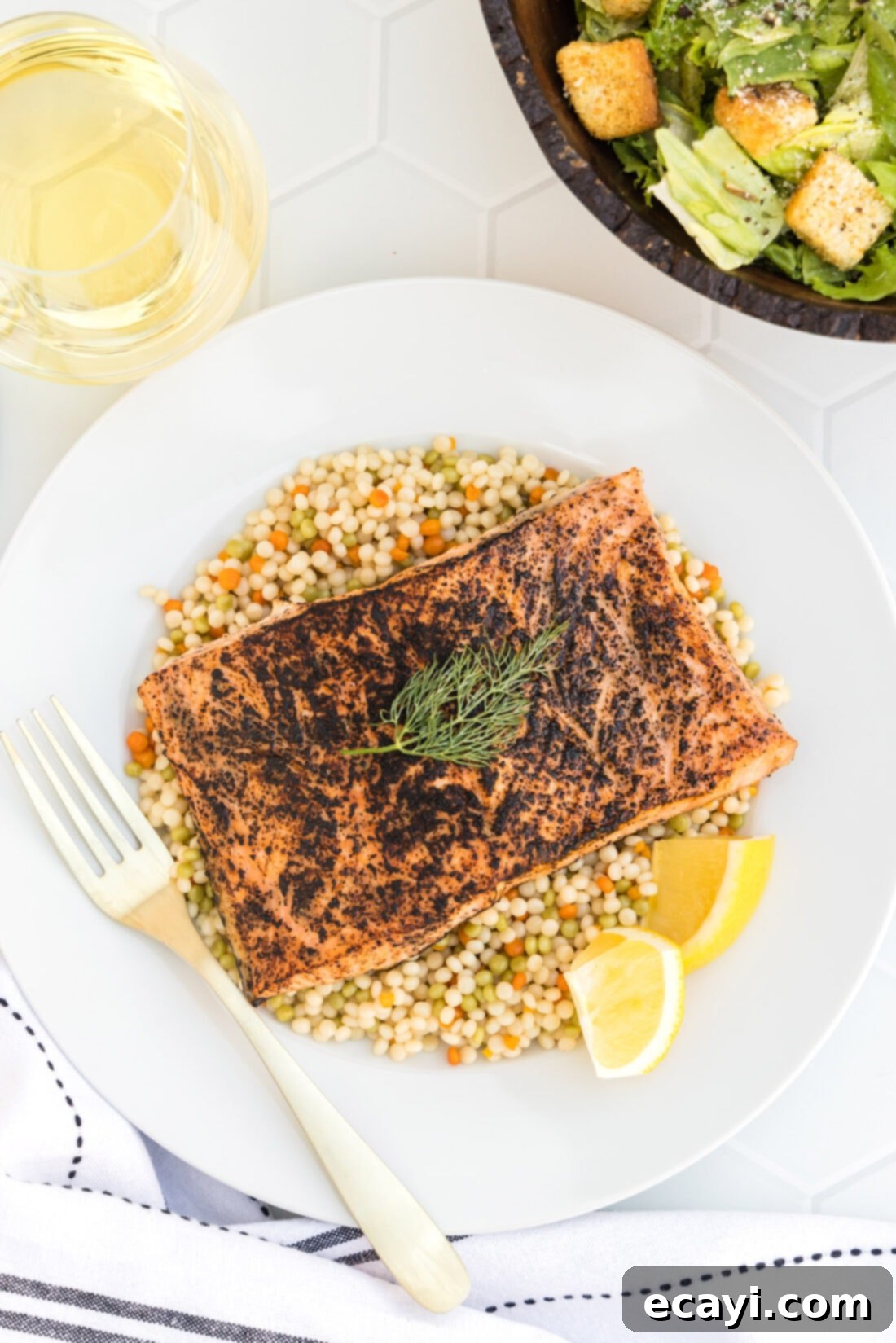
Delicious Serving Suggestions for Your Sous Vide Salmon
Once your sous vide salmon is perfectly cooked and seared, the possibilities for serving are endless! Its delicate flavor and moist texture make it incredibly versatile. For a rich and indulgent experience, optionally top your sous vide salmon with our creamy rosemary cream sauce. The herbaceous notes of the sauce perfectly complement the salmon. Alternatively, a simple squeeze of fresh lemon juice is often all you need to brighten its natural flavors.
Pair your exquisite salmon with a variety of wholesome side dishes. A classic choice is a side of roasted potatoes, their crispy exterior and fluffy interior providing a lovely contrast. For a lighter meal, consider serving it with steamed or sautéed vegetables such as vibrant green beans, tender asparagus, nutrient-rich broccoli, or sweet glazed carrots. The simplicity of these vegetables allows the salmon to truly shine.
If you’re looking for a heartier base, serve your salmon over a bed of fluffy white or brown rice, allowing it to soak up any delicious juices. For an elevated twist, our zesty lemon couscous offers a light, bright, and flavorful accompaniment that pairs wonderfully with seafood. You could also flake the cooked salmon into a fresh salad, incorporate it into a delicious salmon sandwich, or even serve it atop a warm quinoa bowl with your favorite roasted vegetables and a drizzle of tahini dressing. The versatility of sous vide salmon means you can enjoy it in countless ways. Enjoy!
Discover More Delicious Salmon & Sous Vide Recipes
If you’ve enjoyed the ease and perfection of sous vide salmon, you might be interested in exploring other fantastic salmon preparations or venturing further into the world of sous vide cooking. Here are some related recipes that are sure to inspire your next meal:
- Poached Salmon: For an incredibly light and moist cooking method without the sear.
- Pan Seared Salmon: A classic method for achieving a crispy skin and tender interior.
- Maple Soy Salmon: A delicious sweet and savory glaze that elevates your salmon.
- Cedar Plank Salmon: For a smoky, aromatic flavor, perfect for grilling enthusiasts.
- Sous Vide Pork Chops: Experience the same precision cooking for incredibly tender pork.
I absolutely adore sharing my passion for baking and cooking, along with all my kitchen experiences, with each and every one of you! Remembering to visit back every day for new inspiration can sometimes be a challenge, which is precisely why I offer a super convenient newsletter. Every time a new, delicious recipe posts, it lands directly in your inbox. Simply subscribe today and start receiving your free daily recipes, making meal planning and cooking easier and more enjoyable!
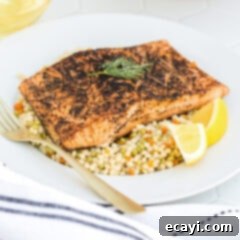
Sous Vide Salmon
IMPORTANT – There are often Frequently Asked Questions and Expert Tips within the blog post that you may find incredibly helpful. Simply scroll back up to read them for more insights!
Print It
Pin It
Rate It
Save ItSaved!
Ingredients
- 1 ½ pounds center cut salmon cut into 2 large filets
- ½ Tablespoon garlic salt
- 1 teaspoon black pepper
- 2 ½ Tablespoons olive oil
- 2 sprigs fresh herbs we used 1 rosemary and 1 dill
Things You’ll Need
-
Sous vide water container
-
Sous vide cooker
-
Food saver vacuum sealer and bags
-
Vinyl gloves
-
Kitchen torch
Before You Begin
- Instead of a kitchen torch, you can simply sear the sous vide salmon in a hot skillet with some olive oil or butter. You will want the pan hot so that you can sear it quickly, ensuring a beautiful crust without overcooking the perfectly tender interior. If you take too long to sear it, the fish is already cooked through so it could begin to flake apart.
Instructions
-
Fill your sous vide water container to the appropriate level and securely position your sous vide cooker. Preheat the sous vide cooker to 130°F (54.4°C) for optimal medium-rare to medium doneness.
-
In a small bowl, whisk together the olive oil, garlic salt, and black pepper until well combined, creating your flavorful rub.
-
Using gloved hands, thoroughly coat both sides of each salmon fillet with the prepared oil and seasoning mixture, ensuring even coverage.
-
Break the rosemary sprig into a few larger pieces (small enough to fit in the bag but large enough to easily remove). Place these herb pieces, along with any dill, on top of the seasoned salmon fillets.
-
Place each seasoned fillet with fresh herbs into individual vacuum seal bags. Use your vacuum sealer to remove all air and seal them shut, or use the water displacement method if you don’t have a sealer.
-
Submerge the sealed salmon bags into the preheated 130°F (54.4°C) water bath. Sous vide the salmon for 45 minutes, ensuring consistent temperature and perfect cooking.
-
Once cooked, remove the salmon from the bags and gently place the fillets on a wire rack. Discard the herbs. Pat the salmon dry with paper towels to prepare for searing.
-
Using a kitchen torch, quickly sear the outside of the cooked salmon until a beautiful, crisp, golden-brown crust forms. This adds flavor and texture without further cooking the interior.
Nutrition
The recipes on this blog are tested with a conventional gas oven and gas stovetop. It’s important to note that some ovens, especially as they age, can cook and bake inconsistently. Using an inexpensive oven thermometer can assure you that your oven is truly heating to the proper temperature. If you use a toaster oven or countertop oven, please keep in mind that they may not distribute heat the same as a conventional full sized oven and you may need to adjust your cooking/baking times. In the case of recipes made with a pressure cooker, air fryer, slow cooker, or other appliance, a link to the appliances we use is listed within each respective recipe. For baking recipes where measurements are given by weight, please note that results may not be the same if cups are used instead, and we can’t guarantee success with that method.
